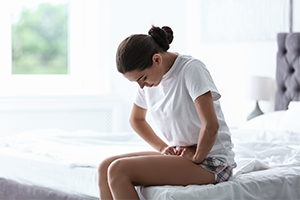
Endometriosis affects about 11% of women of reproductive age, but many people don’t know what it is—and many women may not know that they have it. Endometriosis occurs when the lining of the uterus (called the “endometrium”) is present outside of the uterus. Most commonly, endometriosis occurs on the surrounding organs, like the fallopian tubes or ovaries, bladder, rectum or intestines. Lesions can grow on these organs, and because endometriosis responds to a woman’s monthly menstrual cycle, sheds at the same time that her endometrium lining inside the uterus sheds, making for extremely painful cramps that may not limit themselves to any particular time of the month.
Occasionally, endometriosis can grow on the vagina, vulva, cervix, bowel, bladder or rectum.
What are the symptoms?
The first and biggest symptom of endometriosis is extreme pain. This is a different type of pain than the normal pain that comes with monthly menstrual cramps, when the uterus contracts to expel the endometrium if a fertilized egg or embryo has not implanted in the uterine wall. Endometriosis pain includes very painful menstrual cramps that get worse over time, chronic pain in the lower back and pelvis, pain during or after sex, intestinal pain, painful bowel movements or pain when urinating during menstrual periods.
Endometriosis is so painful because these growths swell and bleed outside of the uterus just like the lining of the uterus does—except they don’t belong to the places where they attach. Swelling and pain can occur because the tissue grows and bleeds in an area where it cannot easily be expelled from your body. If endometriosis growths get big enough, they can completely block Fallopian tubes, cause cysts to form in the ovaries, or cause inflammation and swelling in these areas. Untreated endometriosis can cause scar tissue and adhesions that can cause extreme pelvic pain and make it difficult to get pregnant.
Bleeding or spotting between menstrual periods is another symptom, as well as digestive problems of any sort like constipation, bloating, and nausea. Some additional symptoms are:
• Pelvic pain, either constant or with a pattern
• Fatigue, exhaustion or low energy
• Diarrhea or other upset stomach
• Heavy or irregular periods
How is it diagnosed and treated?
Women who think they have endometriosis should see a doctor immediately, as endometriosis can get worse over time if left untreated. A doctor will perform a pelvic exam to feel for large cysts or scars. Smaller cysts and scars need to be seen via ultrasound or MRI.
Treatment for endometriosis can vary from woman to woman. Hormonal birth control regimens are the most common treatment for endometriosis, along with gonadotropin-releasing hormone agonist medications that block the menstrual cycle and lower the amount of estrogen the female body makes. A laparoscopic surgery to check and remove endometriosis may be prescribed in severe cases. A doctor can visually identify the lesions and take a biopsy of the growths to confirm the diagnosis. Several other pain medicines are sometimes prescribed to endometriosis patients to help with the extreme pain that endometriosis brings.
What effect does it have on fertility?
Many women with endometriosis get pregnant successfully, but many do not. Women with endometriosis may find it more difficult to conceive or sustain a pregnancy. Nobody knows exactly how endometriosis affects fertility, but the endometrium is an essential part of pregnancy, so any change, trauma or inflammation of the endometrium may cause issues. Patches of endometriosis may break off and change the shape of the pelvis and reproductive organs. Endometriosis may completely block the Fallopian tubes, causing an egg to not be able to travel through the tubes from the ovaries. The immune system may attack an embryo attempting to implant into the uterine lining. The uterine lining may not develop as it should and may not sustain a pregnancy.
How to cope with endometriosis
Endometriosis can be as big a mental challenge as a physical one. Learning to cope with an endometriosis diagnosis can be difficult, but a necessary path to help heal and recover. Logging symptoms and being honest with your physician can go a long way in getting the necessary and needed treatment for endometriosis. Early diagnosis and intervention is key for endometriosis.
Disclaimer: The contents of this article, including text and images, are for informational purposes only and do not constitute a medical service. Always seek the advice of a physician or other qualified health professional for medical advice, diagnosis, and treatment.









Leave a reply